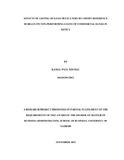| dc.description.abstract | Banks face a major threat when incidences of Non-Performing Loans (NPLs) increase.
NPLs represent bad loans that the borrowers engage in and fail to obey the repayment
obligations. NPL affects the psychology of a banker in terms of their funds disposition
towards credit delivery and expansion. As such non-performing loans generate a vicious
effect on banking survival and growth which if not timely managed in a proper way may
lead to banking failures. In Kenya, due to the high banking failures, credit information
sharing mechanism was launched in July 2007. This gave birth to credit reference bureau.
The use of CRB extends to sharing information merged from other sources such as
criminal records, tax records. All these data of information is compiled together and used
to assign credit scores of borrowers based on statistical risk analysis. It is expected that
use of CRB would reduce giving loan to risky customers. This study sought to establish
the effect of listing loan defaulters by credit reference bureaus on the level of nonperforming
loans in commercial banks in Kenya. The study used a descriptive survey
design, targeting all commercial banks in Kenya. A census of all commercial banks in
Kenya was done. Secondary data was used in this study. The research obtained
quantitative data. Descriptive and inferential statistics was employed in data analysis with
aid of the Statistical Package for Social Sciences (SPSS) package. The study revealed that
that there existed a negative relationship between the level of non-performing loans in
commercial banks and listing of loan defaulters. The study also established that an
increase in interest rate weakens loan repayment capacity of the borrower therefore nonperforming
loans and bad loans are positively correlated with the interest rates. Further, it
was established that a bank‟s size indicates a higher likelihood of a diversified loan
portfolio, the capital of banks serves as a custom for protection of depositors‟ funds.
Finally, the study established that a rise in inflation led to a decrease in the amount of
non-performing loans. The study recommends that commercial banks in Kenya should
assess their clients and charge interest rates accordingly, as ineffective interest rate policy
can increase the level of interest rates and consequently NPA. Commercial banks should
also apply rigorous policies on loan advances so as loans are awarded to those with
ability to repay and mitigate moral hazards such as insider lending and information
asymmetry. Banks should apply efficient and effective credit risk management that will
ensure that loans are matched with ability to repay, no or minimal insider lending, loan
defaults are projected accordingly and relevant measures taken to minimize the same.
The banks should also enhance periodic/regular credit risk monitoring of their loan
portfolios to reduce the level of NPA. | en_US |

